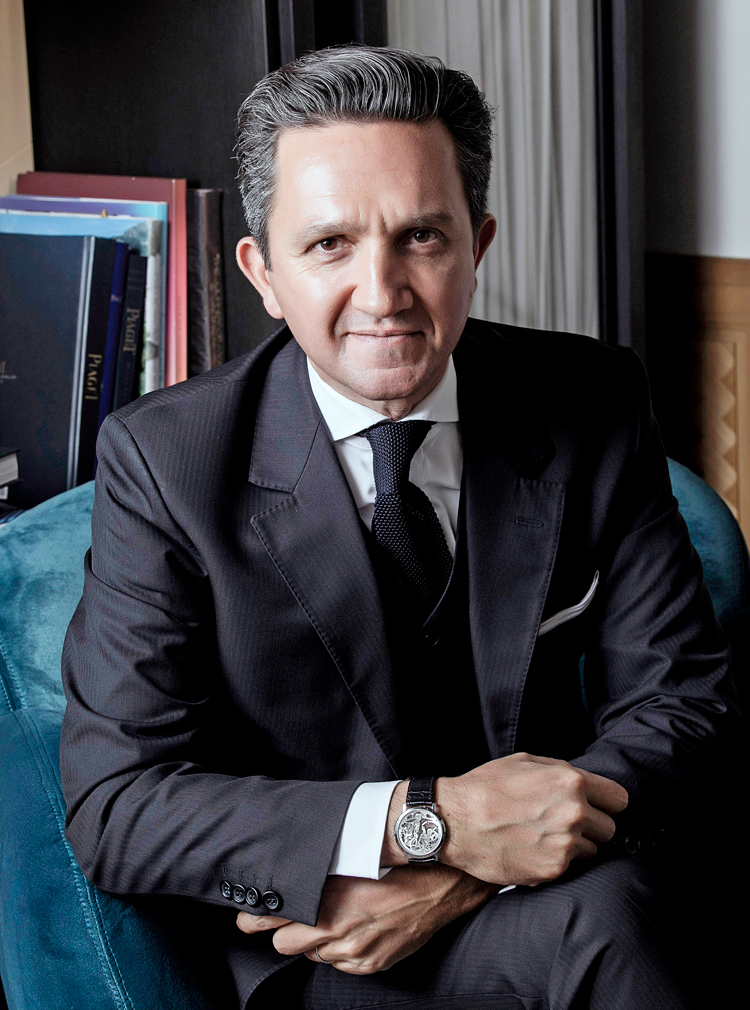
With a jeweller such as Piaget traditional craftsmanship is at the heart of the House. In a world where there is increasing pressure to use new technologies, Piaget strives to preserve the classic techniques that have been unique to the House for over 100 years and can be carried out by only the most skilled craftsman. From the first sketch to the last polish, Piaget’s High Jewellery collections are created with the utmost care and passion.
At the heart of this is Piaget’s High Jewellery Director, Christophe Bourrie. Bourrie is responsible for overseeing the creation process of Piaget’s High Jewellery collections and ensuring they are made in a way that is true to the DNA of the House. Here we discuss with Bourrie the importance of craftsmanship and how art and colour inspire Piaget’s High Jewellery designs.

How important is preserving traditional craftsmanship in the creation of Piaget’s High Jewellery?
High Jewellery is all about craftsmanship, creativity and exceptional stones. The expertise of the jeweller is key in creating exceptional pieces and nothing will ever replace the hands of our artisans. At Piaget, we see High Jewellery as the art of sublimating precious stones. The skills of our artisans come from traditional apprenticeships and they all benefit from years of experience.
At Piaget, we push our historical and traditional know-how further to adapt it to contemporary creations that are relevant today. Both our designers and artisans work hand in hand to adapt our traditional crafts in a modern way. The perfect example is how we transform the palace engraving (traditionally used on our jewellery watches), onto unique necklaces or cuffs. The shine of the engraving plays with the light of the diamonds and coloured gemstones in a unique and original way.
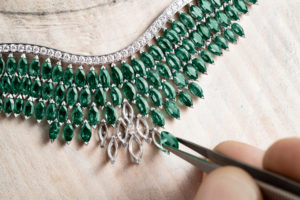
How does Piaget embrace new technologies but continue to sustain traditional techniques?
Piaget creates High Jewellery in a traditional way, it is rather the style and the ways of wearing it that are evolving. Nevertheless, we like to push the boundaries by working with Maître d’Arts, nurturing traditional and unique crafts such as using feathers or wood marquetry and innovating with them on audacious creations.
How do you think the world of art and design influences jewellery making?
Our internal design studio is very much taking inspiration from the surrounding world for the creative process. Their aim is to perpetuate the Piaget DNA, while instilling it with inspirations from nature, art, fashion, etc. Piaget as a Maison has always been very closely linked to the world of art, especially by approaching the Piaget creations as art pieces: we like to say that Piaget’s artisans are artists, and our creations are presented as pieces of art.

Can you tell us a little about the choice of colour combinations and colour choices within Piaget’s collections?
Colour is very important to Piaget. In 1963, Piaget launched its first colour dials in hard stones, a true milestone for the brand. Ever since then, the Maison has been using colour in all of its creations and collections, whether through using gemstones, hardstones, mother of pearl, feathers, precious woods or many other materials. The choice of colour is so important. Our colours are vibrant and strong, highlighting the boldness and differentiation of the Maison.
Are there any particular stones or colours you love to work with?
Hard stones are definitely a favourite as they are part of Piaget’s DNA and we even use them in our High Jewellery collections, mixing them with the most exceptional gemstones. If there is one colour that stands out, it would have to be blue. The blue of Lapis Lazuli, but also turquoise blue in Turquoise and Paraiba tourmalines. Green (emeralds, malachite, and chrysoprases) also stand out as well as red (rubies, carnelians and corals). As said before, the colours used at Piaget are very vibrant and strong.
It is important to mention the huge research that is conducted by our gemology team as we only work with natural, non-treated and non-heated precious stones. A lot of patience is required to find the most beautiful and natural stones, while continuing to strive to use unique and vibrant colours.
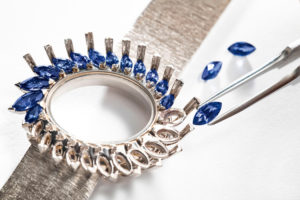
Are there any particularly intricate techniques used in the jewellery making process you can tell us a little about?
In every new collection, we try to come up with something new. As mentioned before, our craftsmanship remains traditional, but we try to work with new materials and new ways of wearing the pieces. Transformability is one important point we are working on. Today, when a client buys a piece of High Jewellery, we try to offer them multiple ways of wearing it. For example, a pear-cut diamond can be removed from a statutory necklace to be worn on a simple chain, or a large pendant can also be worn as a brooch. We challenge our Ateliers de l’extraordinaire to be able to come up with innovative and surprising ideas.
When it comes to the initial design, where do you start? Are all of the pieces still hand sketch or is this done digitally?
In traditional High Jewellery, everything starts from the centre stone. The drawing and the inspiration come directly from this gemstone. However, for some creations, it can also be the case that the designer imagines a piece from scratch. The designer then asks our gemology team to find the matching stones, which can sometimes be quite challenging. The design today is still carried out by hand, using the gouache technique. It is then the work of the jeweller, hand-in-hand with the designer, to work on the 3D version.
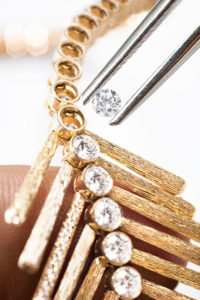
What do you think customers are looking for today in terms of the savoir-faire and design in jewellery?
Today our customers are more and more educated and aware when it comes to High Jewellery pieces. The quality of our precious stones is crucial. It is our priority to find the most beautiful and precious stones that nature has to offer.
Then comes the design. As a contemporary jeweller, at Piaget, we like to affirm our style, and the creativity in our pieces. Our creations are intended for people who say yes to life and like to be different.
How does the heritage of Piaget influence today’s new pieces and collections?
Piaget’s style and DNA can be seen throughout all of our creations thought their movement, asymmetry, fluidity, colour, audacity, etc. Then come our signature pieces, such as the cuff (in jewellery and watches) or the sautoirs, that recall the creative period of the 80s.
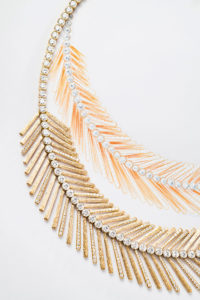
What is the biggest challenge of your role?
It is definitely to carry-on the heritage, history and savoir-faire of Piaget from 1874 to each and every High Jewellery piece to make sure our clients continuously recognise the signature style that they appreciate in our creations. It takes years to create and launch our High Jewellery collections and they will be carried out by our clients for eternity. Therefore the entire team feel very liable for each piece which is for sure, a strong motivation.

What is one secret you can share with us regarding Piaget’s High Jewellery?
While looking for exceptional stones for the recent High Jeweller collections, Piaget’s gemologists remembered a 30-year-old legend. According to them, a sapphire of rare beauty was discovered in the early eighties. Locals still remember this gift of nature which disappeared as quickly as it appeared…It was too beautiful…they had to find this gem! After searching for a year, they finally found this breathtaking blue sapphire. The stone was called “Piaget Blue”, as a tribute to the signature blue colour of the Maison. It is a cushion-cut unheated blue sapphire of 53.45 carats.
READ MORE:
Amanda Ellison, Global President of WatchBox Discusses the Preowned Watch Market in the Middle East
Discover Boucheron’s 2020 Timeless High Jewellery Collection, Celebrating the Icons of the House
The Making of Van Cleef & Arpels’ Frivole Collection















